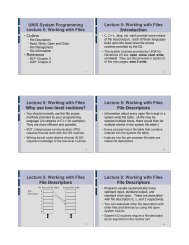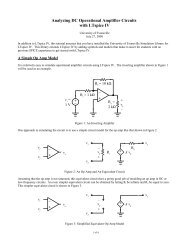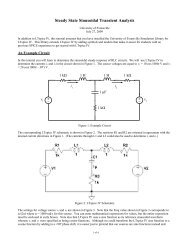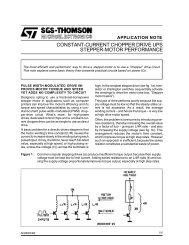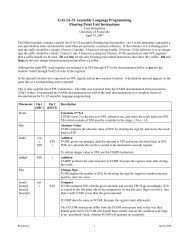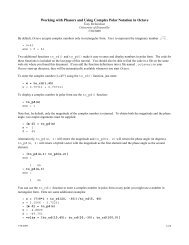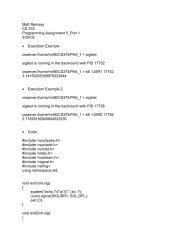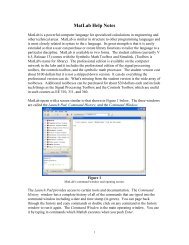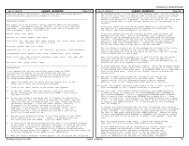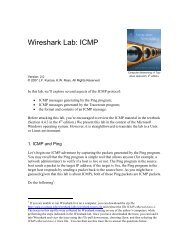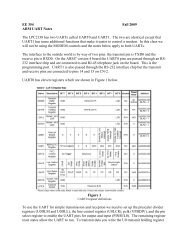Winburg Mini Case Study - csserver
Winburg Mini Case Study - csserver
Winburg Mini Case Study - csserver
Create successful ePaper yourself
Turn your PDF publications into a flip-book with our unique Google optimized e-Paper software.
CS 390 – Lecture 3<br />
Chapter 2: Software Life Cycle Models<br />
Ideally, software is<br />
developed as described<br />
in Chapter 1 (Figure 2.1)<br />
Linear<br />
Starting from scratch<br />
September 1, 2008 Lecture 3 1<br />
<strong>Winburg</strong> <strong>Mini</strong> <strong>Case</strong> <strong>Study</strong><br />
Set up public transportation system<br />
to reduce traffic congestion<br />
Use bus-only lanes and park-andride<br />
lots<br />
Each bus fare machine accepts only<br />
dollar bills<br />
Response must be fast (avg. <<br />
1sec) and accurate (avg. 98%<br />
correct)<br />
September 1, 2008 Lecture 3 3<br />
<strong>Winburg</strong> <strong>Mini</strong> <strong>Case</strong> <strong>Study</strong> (3)<br />
Episode 4: The requirements change<br />
Want to sell as a product to defray cost<br />
overrun<br />
Accuracy must be increased to 99.5%<br />
Finally, installation for city is complete<br />
Epilogue: A few years later, these<br />
problems recur<br />
New hardware => new software<br />
New software => new design and<br />
programming language to be “better”<br />
September 1, 2008 Lecture 3 5<br />
Software Development in Practice<br />
In the real world, software<br />
development is totally different<br />
We make mistakes<br />
The client’s requirements change while<br />
the software product is being<br />
developed<br />
September 1, 2008 Lecture 3 2<br />
<strong>Winburg</strong> <strong>Mini</strong> <strong>Case</strong> <strong>Study</strong> (2)<br />
Episode 1: The first version is<br />
implemented<br />
Episode 2: A fault is found<br />
The product is too slow (avg. 10sec) because<br />
of an implementation fault (double precision vs<br />
single precision)<br />
Changes to the implementation are begun<br />
Episode 3: A new design is adopted<br />
Change will still be too slow. A faster<br />
algorithm is used<br />
September 1, 2008 Lecture 3 4<br />
Waterfall Model<br />
The linear life cycle<br />
model with feedback<br />
loops (Figure 2.3)<br />
The waterfall model<br />
cannot show the order of<br />
events<br />
September 1, 2008 Lecture 3 6<br />
1
Evolution-Tree Model<br />
<strong>Winburg</strong> <strong>Mini</strong> <strong>Case</strong> <strong>Study</strong> (Figure 2.2)<br />
September 1, 2008 Lecture 3 7<br />
Lessons of the <strong>Winburg</strong> <strong>Mini</strong> <strong>Case</strong><br />
<strong>Study</strong><br />
In the real world, software<br />
development is more chaotic than<br />
the <strong>Winburg</strong> mini case study<br />
Changes are always needed<br />
A software product is a model of the<br />
real world, which is continually<br />
changing<br />
Software professionals are human, and<br />
therefore make mistakes<br />
September 1, 2008 Lecture 3 9<br />
Moving Target Problem<br />
A change in the requirements while<br />
the software product is being<br />
developed<br />
Even if the reasons for the change<br />
are good, the software product can<br />
be adversely impacted<br />
Dependencies will be induced<br />
September 1, 2008 Lecture 3 11<br />
Evolution-Tree Model (2)<br />
The explicit order of events is<br />
shown<br />
At the end of each episode<br />
We have a baseline, a complete set of<br />
artifacts (constituent components)<br />
Example:<br />
Baseline at the end of Episode 3:<br />
Requirements 1 , Analysis 1 , Design 3 ,<br />
Implementation 3<br />
September 1, 2008 Lecture 3 8<br />
Teal Tractors <strong>Mini</strong> <strong>Case</strong> <strong>Study</strong><br />
While its ERP software product is being<br />
constructed, the requirements change: The<br />
company is expanding into Canada<br />
Changes needed include:<br />
Additional sales regions must be added<br />
Must be able to handle Canadian taxes and other<br />
business aspects that are handled differently<br />
Must be extended to handle two different<br />
currencies, US$ and CDN$<br />
These changes may be<br />
Great for the company; but<br />
Disastrous for the software product<br />
September 1, 2008 Lecture 3 10<br />
Moving Target Problem (2)<br />
Any change made to a software<br />
product can potentially cause a<br />
regression fault<br />
A fault in an apparently unrelated part<br />
of the software<br />
If there are too many changes<br />
The entire product may have to be<br />
redesigned and reimplemented<br />
September 1, 2008 Lecture 3 12<br />
2
Moving Target Problem (3)<br />
Change is inevitable<br />
Growing companies are always going to<br />
change<br />
If the individual calling for changes has<br />
sufficient clout, nothing can be done<br />
about it<br />
There is no solution to the moving<br />
target problem<br />
September 1, 2008 Lecture 3 13<br />
Miller’s Law<br />
At any one time, we can concentrate on<br />
only approximately seven chunks (units of<br />
information)<br />
To handle larger amounts of information,<br />
use stepwise refinement<br />
Concentrate on the aspects that are currently<br />
the most important<br />
Postpone aspects that are currently less critical<br />
Every aspect is eventually handled, but in<br />
order of current importance<br />
This is an incremental process<br />
September 1, 2008 Lecture 3 15<br />
Classical Phases versus Workflows<br />
Sequential phases do not exist in the real<br />
world<br />
Instead, the five core workflows<br />
(activities) are performed over the entire<br />
life cycle<br />
Requirements workflow<br />
Analysis workflow<br />
Design workflow<br />
Implementation workflow<br />
Test workflow<br />
September 1, 2008 Lecture 3 17<br />
Iteration and Incrementation<br />
In real life, we cannot talk about<br />
“the analysis phase”<br />
Instead, the operations of the analysis<br />
phase are spread out over the life cycle<br />
The basic software development<br />
process is iterative<br />
Each successive version is intended to<br />
be closer to its target than its<br />
predecessor<br />
September 1, 2008 Lecture 3 14<br />
Iteration and Incrementation (2)<br />
Iteration and incrementation are<br />
used in conjunction with one<br />
another<br />
There is no single “requirements<br />
phase” or “design phase”<br />
Instead, there are multiple instances of<br />
each phase<br />
The number of increments will vary<br />
— e.g., <strong>Winburg</strong> <strong>Mini</strong> <strong>Case</strong> <strong>Study</strong><br />
has four<br />
September 1, 2008 Lecture 3 16<br />
Iteration and Incrementation (3)<br />
September 1, 2008 Lecture 3 18<br />
3
Workflows<br />
All five core workflows are performed over<br />
the entire life cycle<br />
However, at most times one workflow<br />
predominates<br />
Examples:<br />
At the beginning of the life cycle<br />
The requirements workflow predominates<br />
At the end of the life cycle<br />
The implementation and test workflows<br />
predominate<br />
Planning and documentation activities are<br />
performed throughout the life cycle<br />
September 1, 2008 Lecture 3 19<br />
<strong>Winburg</strong> <strong>Mini</strong> <strong>Case</strong> <strong>Study</strong> Revisited<br />
Consider the next slide (Figure 2.6)<br />
The evolution-tree model has been<br />
superimposed on the iterative-andincremental<br />
life-cycle model<br />
The test workflow has been omitted<br />
— the evolution-tree model<br />
assumes continuous testing<br />
September 1, 2008 Lecture 3 21<br />
More on Incrementation<br />
Each episode corresponds to an<br />
increment<br />
Not every increment includes every<br />
workflow<br />
Increment B was not completed<br />
Dashed lines denote maintenance<br />
Episodes 2, 3: Corrective maintenance<br />
Episode 4: Perfective maintenance<br />
September 1, 2008 Lecture 3 23<br />
Iteration is performed during each<br />
incrementation (Figure 2.5)<br />
September 1, 2008 Lecture 3 20<br />
<strong>Winburg</strong> <strong>Mini</strong> <strong>Case</strong> <strong>Study</strong> Revisited (2)<br />
September 1, 2008 Lecture 3 22<br />
Other Aspects of Iteration and<br />
Incrementation<br />
We can consider the project as a whole as<br />
a set of mini projects (increments)<br />
Each mini project extends the<br />
Requirements artifacts<br />
Analysis artifacts<br />
Design artifacts<br />
Implementation artifacts<br />
Testing artifacts<br />
The final set of artifacts is the complete<br />
product<br />
September 1, 2008 Lecture 3 24<br />
4
Other Aspects of Iteration and<br />
Incrementation<br />
During each mini project we<br />
Extend the artifacts (incrementation);<br />
Check the artifacts (test workflow); and<br />
If necessary, change the relevant<br />
artifacts (iteration)<br />
Each iteration can be viewed as a<br />
small but complete waterfall lifecycle<br />
model<br />
September 1, 2008 Lecture 3 25<br />
Strengths of the Iterative-and-<br />
Incremental Model<br />
There are multiple opportunities for<br />
checking that the software product is<br />
correct<br />
Every iteration incorporates the test workflow<br />
Faults can be detected and corrected early<br />
The robustness of the architecture can be<br />
determined early in the life cycle<br />
Architecture — the various component modules<br />
and how they fit together<br />
Robustness — the property of being able to<br />
handle extensions and changes without falling<br />
apart<br />
September 1, 2008 Lecture 3 27<br />
Strengths of the Iterative-and-<br />
Incremental Model (3)<br />
There is empirical<br />
evidence that the<br />
life-cycle model<br />
works<br />
The CHAOS<br />
reports show that<br />
the percentage of<br />
successful<br />
products<br />
increases (Figure<br />
2.7)<br />
September 1, 2008 Lecture 3 29<br />
Other Aspects of Iteration and<br />
Incrementation<br />
During each iteration we select a<br />
portion of the software product<br />
On that portion we perform the<br />
Classical requirements phase<br />
Classical analysis phase<br />
Classical design phase<br />
Classical implementation phase<br />
September 1, 2008 Lecture 3 26<br />
Strengths of the Iterative-and-<br />
Incremental Model (2)<br />
We can mitigate (resolve) risks early<br />
Risks are invariably involved in software<br />
development and maintenance<br />
We have a working version of the<br />
software product from the start<br />
The client and users can experiment with this<br />
version to determine what changes are needed<br />
Variation: Deliver partial versions to<br />
smooth the introduction of the new<br />
product in the client organization<br />
September 1, 2008 Lecture 3 28<br />
Strengths of the Iterative-and-<br />
Incremental Model (4)<br />
Reasons given for the decrease in<br />
successful projects in 2004 include:<br />
More large projects in 2004 than in<br />
2002<br />
Use of the waterfall model<br />
Lack of user involvement<br />
Lack of support from senior executives<br />
September 1, 2008 Lecture 3 30<br />
5
Managing Iteration and Incrementation<br />
The iterative-and-incremental lifecycle<br />
model is as regimented as the<br />
waterfall model …<br />
… because the iterative-andincremental<br />
life-cycle model is the<br />
waterfall model, applied<br />
successively<br />
Each increment is a waterfall mini<br />
project<br />
September 1, 2008 Lecture 3 31<br />
6



